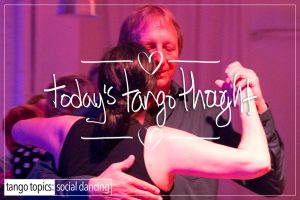If you’ve been dancing for a while, you may recognize a tendency in yourself or others, a drive to be better dancers. The drive, seemingly in your opinion, detracts from the ‘fun’ that you’re having. And each and every time you go deeper with the dance, it just ruins everything. The study part makes it difficult to find the ‘fun’ again. Classes just confuse and don’t really do much for you. Workshops are about the same. And private lessons just make you all tense and focused on being a perfectionist. Or so you believe. Then not to mention, there’s (if you’re a Follower) a good deal of sitting or (if you’re a Lead) not getting the dances from people you want to dance with. At some point you ask “where’s the fun in that ?”.
That’s a really great question!
Believe it or not, the ‘fun’ part is everywhere. You are focused on just the outcome of the dancing part. The immediate hit that you get from dancing. But what if you found out that you’re only scratching the surface with Tango. What if you discovered that you’re missing a very important aspect that can not only change the dance from what it is today for you but for it to go far deeper than you ever imagined. What if you found out that the drive to be ‘better’ is not only a requirement, but is the gateway to dancing with better and better partners that you only dreamt of dancing with if you only changed your perspection a bit ?
Tango is not a ‘plug and play’ dance where you can just learn a few steps/patterns/figures in a 5 minute lesson and then you have 10 second mastery over and now you instantly know ‘tango’. No. Tango requires study (learning the ‘how to’) in order to engage in the ‘fun’ part that you want. Without that study part, you’re going to end up an unhappy person for a variety of reasons. The reality is that Tango takes time to develop, patience to persist, and lots of study time to get to the ‘fun’ you seek. To be clear: ‘Time’ is longer than a few years. In today’s world, longer than a few minutes is hard to imagine, and this page is stating ‘years’, wtf ?. Yes, YEARS! ‘Patience’ is an absolute requirement, you’re going to try, you’re going to fail (a lot), you’re going to screw up, you’re going to look foolish, you’re going to succeed in bits, pieces, fits and starts, and then fail again. Over and over and over, if you’re lucky. There is no ‘done’ in tango. And lastly ‘Study’ means musical, historical, technique, again, and again, and again. The reason for the repetition is to immerse yourself in the movements, customs, music of the environment that you’re in.
Think of Tango as if it were a language. When you first start out with a new language, you can barely understand what’s being said, let alone read the text of the new language. It’s all gobbly-gook to you. And like any language it takes time, patience, and lots of practice before you can speak that language to the point where you can express yourself. Tango is no different in this respect. You must learn the language before you can speak it, think in it, and dream in it.
Extending the metaphor a bit, like any language Tango, has a very specific vocabulary consisting of 3 parts: 1.) Nouns, verbs, adjectives, and phrases. e.g. embrace, posture, walking, ochos, turns, crosses etc. 2.) Sentences and sentence structure. Think of this as putting those nouns/verbs etc into cohesive simple sentences and then complex sentences. Or from a Tango perspective walking, ochos, turns, crosses in time to the beat, pauses, and musical phrases within the a structure. And lastly 3.) Speaking. You must speak the language, use it frequently, so that it becomes 2nd nature to you. Or from a Tango perspective you must dance frequently, as often as possible under many, many conditions.
These 3 parts are all skill building, and it’s also part of the ‘fun’ process. It’s not just about the destination, but the journey of how you got there.
At the same time, it should be noted that when you’re learning a new language, you need to be corrected when you say or write something that is incorrect. This is especially true as you become more and more facile with the language. You’re going to make mistakes, that’s a given, but unless someone comes along and corrects you, constantly keeping after you to change how you say something, how you use a phrase, then you’ll stay in this state of bumbling and fumbling with the language. This same thing happens with Tango. There’s a lot of fumbling and bumbling going on even though there is the perception of fluency. It’s an in-between stage that a lot of people (about 80%) never get beyond with Tango. The hard part is that the more time you spend in this state, the more entrenched you become in the belief that you’re doing well, when in fact that’s not the case at all (body contortion, instability, embrace issues, poor vocabulary execution, hanging, pulling, pushing, resistance, tension, force). You need constant correction to reach a state of fluency and facility with Tango. This is not achieved overnight. It takes years and years to get there, and those corrections must happen frequently. You are learning a new way of moving, and even though you think you’ve got it. You don’t. Patience, time, practice, and persistence. 🙂
Just as a side note it should be pointed out that there are those that end up speaking with an accent of the language. That accent when used with a native speaker makes the language sound almost unintelligible. Using English as an example: A deep Southern Accent of American English, an Irish, Indian, or any of the multiple English accents, or Scottish accent of English, when spoken to a native English speaker confuses them a bit, and they have to listen harder to focus on the words. Imagine a non-native speaker listening to that ? Tango has it’s accents, in the embrace, in the walk, in how to hear the music. Sometimes these are best classified as ‘styles’, and those ‘styles’ are variations on a theme that can and do create areas where the dancing partner has to stop for a moment and wonder WTF was that ? Was that an ocho ?
To be clear: 90% of people, stop their education once they reach a very specific point. This point, which is callously described as ‘just getting good enough to get around the room so that you don’t embarrass yourself’. Once this point of proficiency is reached people stop developing. This is ‘good enough’. Anything beyond this is as seen as seeking perfection, or being egotistical, or arrogant. Yet it is precisely that perfection seeking, to be better, that can create a much better dancer, so that in turn you end up being a better partner for other people to dance with, and thereby creating a much better dancing experience, and more ‘fun’.
This is about building a skill to the point of fluency. You want to be able to speak the language of Tango fluently, easily, with precision, grace, and without effort, with anyone, anywhere, at any time. 🙂 And that means study, practice, study some more, lots more practice, patience, repeat. So that in the end, you can speak with anyone! That’s where the fun part is.
Transcendence ? For most people when they hear or read the word ‘Trancendence” they immediately think “other worldly”. And while there is a air of truth to this, when it comes to Tango you’re not going to transported to another world. No. You’re going to say right here on Terra Firma. However the sensation will be one of “OMFG!”. And part of the reason why it’s “OMFG” is due to the fact that the practicioner is engaging in a state of creation joy, or to put it simply “fun”. Unfortunately in order to get to that state, it requires work, hard work, of the practicioner. Any deviation from their practiced skills, any variation from their ability to execute X, Y, or Z can and will result in losing the state of trancendence that is sought, or the creation joy sensation that they’re chasing. So it is an absolute requirement that you actually study, practice, work, and get to a point of “better” (which is in and of itself a moving target). The end result ? Better equals “Fun” just fun of a different kind that can quite honestly blow the doors off any drug or mood alterating substance you’ve ever taken. Which is to say that all that work you’ve been doing, has a pay off….transcendence. But in order to get there, there’s a lot of hard, and laborious work which starts with cleaning up your foundation, it means no hanging, no pulling, no compression, no force, no resistence, no wobbling, no wavering, no instabilities – anywhere, it means a walk that is clean and unmarred. It means no talking, no yapping while you’re dancing (which isn’t dancing, it’s talking). It means no teaching someone to dance while you’re dancing with them (which is teaching and not dancing). It means no posturing for better and better partners (that’s called being an ass by the way). And it also means engaging in the prospect of “Entrega“! And if you don’t know what that word means. Look it up in the Tango Topics dictionary…right here!
- Glossary: Compression
- Glossary: Vocabulary
- Glossary: Resistance
- Glossary: Foundation
- Glossary: Pulling
- Glossary: Pushing
- Glossary: Tension
- Glossary: Facility
- Glossary: Entrega
- Glossary: Walking
- Glossary: Cross
- Glossary: Lead
- Glossary: Intensive Study
- Glossary: Ochos
- Glossary: Turns
- Glossary: Force
- Glossary: Molinete











